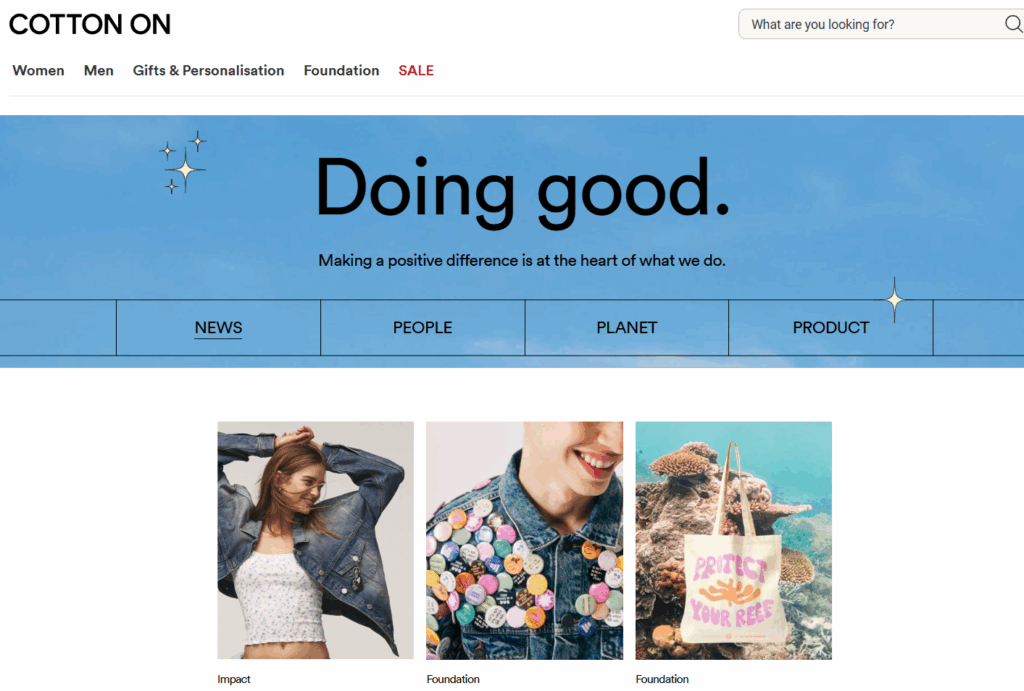Imagine standing before a mirror, fingers tracing the collar of a Cotton On trench coat. The tag reads “Cotton On,” but your thumb brushes against a fabric composition label: 97% polyester. In this moment, we find ourselves suspended in a liminal space between aspiration and accessibility, between the Australia we imagine (laid-back, authentic, connected to land) and the global fashion machine we participate in.
There’s something disarming about Cotton On. At first glance, it’s got that beachy, sun-kissed confidence, selling easy-breezy basics at prices that don’t make your wallet flinch. The brand name whispers natural fibres and sun-drenched coastlines, but is this a synthetic reality?
The Material Conversation
I found myself drawn to Cotton On while searching for brands making genuine sustainability efforts without the prohibitive price tags that often accompany ethical fashion. Their digital presence welcomes you not just with product galleries but with purpose statements.

The first item I picked up was the Lottie Check Trench, it had all the visual markers of longevity: structure, timeless style, versatility. The construction quality impressed me. But the fabric composition told a different story: 97% polyester. From a brand called Cotton On, this created a cognitive dissonance that felt almost poetic in its contradiction. Partly my fault for assumptions made; partly theirs for a name that implies natural fibres.
The redemption arrived in the form of their Boxy Graphic Tee: 100% cotton, with 20% regenerated from pre-consumer waste. This garment had substance, both physical and ethical. It possessed weight, softness, and breathability. But it also carried something less tangible, a grounded integrity. Perhaps this was projection, perhaps not. Either way, it felt meaningful. As if my choice mattered. As if I mattered in making that choice.


Even the packaging reflected this intention: minimal, thoughtful, evidence that someone had consciously chosen not to default to excess.
In this material conversation between brand and consumer, Cotton On speaks in a dialect of incremental progress rather than revolution. It’s a language many of us understand, the vocabulary of trying rather than transforming, of better rather than best.
The Good™ and The ComplicatedThe Good™ and the Complicated
Cotton On doesn’t just sell clothes; it markets a kind of movement. “The Good” serves as their internal compass, directing everything from packaging to education initiatives via the Cotton On Foundation.
Their roadmap to responsibility includes:
- Carbon neutral (Scope 1 & 2) by 2030
- 100% certified responsible viscose and recycled synthetics by 2026
- Fully recyclable/compostable packaging by 2025
- All products with sustainable attributes by 2030
See their sustainability review here

It sounds… familiar. Like the white noise of modern fashion marketing. A constellation of future promises, twinkling distantly.
It’s not perfect, polyester still appears in key garments, there’s limited mention of garment repair or take-back programs, and while ethical labour practices are addressed, they remain less prominent than materials or carbon targets.
But what distinguishes Cotton On is a refreshing openness is a willingness to acknowledge the incompleteness of their journey. That rare humility makes a difference in an industry often characterised by greenwashing and exaggerated claims.
There’s a quiet dignity in garments that align not just with your body but with your evolving values. Cotton On doesn’t reinvent silhouettes or push fashion boundaries. It doesn’t preach. It doesn’t claim to be saving the world single-handedly. But it does offer a different rhythm, one that attempts to slow the relentless tempo of fast fashion without cutting off access entirely.
And that’s worth noting: in a world where sustainable fashion brands too often feel elitist or exclusionary, Cotton On’s offering feels democratic. As if perhaps doing better doesn’t always have to mean doing without.
Final Thoughts
The pursuit of affordable sustainable fashion remains one of the industry’s most significant challenges. Cotton On exists in this tension, between the rising tide of environmental consciousness and the undertow of economic accessibility. It’s a brand caught between waves, trying to ride both without being pulled under by either.
Would I shop there again? Yes! Cautiously and consciously. Would I recommend them? To someone beginning their slow fashion journey, absolutely. But I’d also advise: read the labels, not just the headlines. Let intention guide you, but let information anchor you.
Slow fashion isn’t just about how we buy. It’s about what we’re collectively building, a different relationship with material culture, with expression, with the stories we tell through what we wear.
Before tapping add to cart, ask yourself: Who made this? Under what conditions? What does this brand value, and am I okay aligning with that? We don’t need to be perfect consumers, but we do need to be conscious ones. Because every dollar spent is a vote for the kind of world we want clothed—and the kind of labour, materials, and values we’re willing to let touch our skin.

